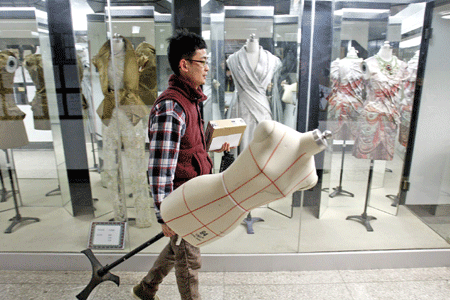|
KARACHI: The textile sector is the backbone of the national economy as it has direct contribution to domestic production, financial services and foreign exchange earnings.
The sector has strong implications on socio-economic conditions of the country given its role in employment generation.
The sector had to face deprivation with intensified power outages and gas shortages. The textile industry lost $1 billion exports in first half of current fiscal year and likely to lose another $2 billion in second half of this fiscal.
Chairman, All Pakistan Textile Mills Association (APTMA) Mohsin Aziz said on Tuesday drop in exports of textile quantity $305 million in December 2011 was alarming.
Unprecedented energy shortage was prime reason behind substantial drop in exports, he added.
The situation would be alarming further in January 2012, as textile industry particularly in Punjab is denied electricity and gas supplies since December 25 till date.
Textile exports dipped 40 percent in December 2011 in quantity terms. In November 2011, textile exports were also 32 percent down in quantity terms added.
He said traditionally textile industry was crossing $1 billion mark of exports monthly, but it was becoming impossible since last three months.
He said APTMA continued showing its concerns over the power and gas shortage, but the government concerned departments failed to readdress their problems. He said policymakers in the Textile Ministry and Ministry of Petroleum and Natural Resources were not serious in resolving gas supply issue of textile industry.
He said the industry was committed to achieve $16 billion exports during current fiscal but it would not be able to achieve more than $12 billion exports if energy crisis persists.
Fibre analyst, Shakeel Ahmad said during the second half of the year, surge in global cotton prices provided earning opportunities in the form of unprecedented high export prices, which in turn induced production activities. Consequently, the textile manufacturing witnessed a growth in 10.9 percent in H2-FY11 compared with a YoY decline by 6.5 percent in the first half. Cotton prices started rising sharply in October 2010 and touched a 150-year record level in February 2011 on the back of both supply and demand factors.
The crop loss in Pakistan and Australia, unfavourable weather in China, declining US inventories and export cap by India also surged prices.
This rise in cotton prices lead to a broad based increase in textile products across the globe, which helped Pakistan earning record $13.8 billion of foreign exchange through textile exports.
The Pakistani manufacturers were struggling with energy shortages and law and order situation that could only uphold their existing market share. Particularly, Pakistan lost its share in US market against India in bed-wear category as buyers switched to import higher-end products. Around 12 percent of Pakistan¡¯s total fabric exports are destined for Turkey.
Bangladesh is a recipient of least developed countries¡¯ (LDC) preferential access to EU market under the GSP.
Textile exports from Bangladesh duty free access to EU under Everything but Arms (EBA) scheme (duty free access is available to only LDCs). This makes textile products of Bangladesh more competitive compared with non-recipients of EBA (including Pakistan). Exports of cotton yarn, cotton cloth, yarn other than cotton yarn, knitwear, bed wear, towel declined by 23 percent, 26 percent, 44 percent, 38 percent, 33 percent and 8 percent respectively in December 2011, causing $305 million loss to exports.
The bed-wear, towels and cotton yarn declined during this period. There were other textile products, including cotton fabrics, hosiery and silk and synthetic items that witnessed rise in both quantum and value terms driven mainly by relatively stable unit prices and competitiveness losses for Chinese products.
The fabric export to Bangladesh may continue to support this sector in Pakistan.
|




